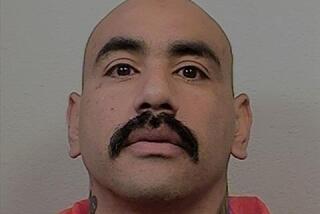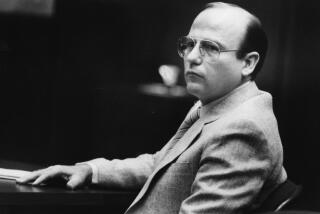Police seek links to grudges in rapper’s death
Detectives said Monday that they were pressing hard to establish whether the drive-by killing of rapper Notorious B.I.G. was part of a deadly grudge between rival groups in rap music.
“We’re not overlooking the fact that this was possibly a hit, a directed target coming out of New York, Los Angeles or Atlanta,” said Los Angeles Police Lt. Ross Moen. “. . . We obviously cannot eliminate the fact there have been a number of murders involving rap singers” in the past.
Police said they have mobilized 20 investigators to interview an estimated 200 witnesses who may have information about who killed the 24-year-old rapper outside a record industry party shortly after midnight Sunday.
The brazen attack stunned rap fans and music executives, who adamantly rejected the notion that the culture of hip-hop music was responsible for such violence.
The rapper, whose real name was Christopher Wallace, was the second so-called gangsta rap sensation in six months to be slain. The other victim was Tupac Shakur, who was killed during a drive-by attack in Las Vegas in September.
In Wallace’s case, Moen said, a gunman in a dark sedan appeared to be lying in wait for the singer, pulling along side Wallace’s vehicle and shooting him through the passenger-side window with a 9-millimeter handgun.
Wallace was driven to a local hospital after the shooting and pronounced dead of multiple gunshot wounds to his upper body.
The murder occurred outside the Petersen Automotive Museum on Fairfax Avenue in Los Angeles’ Mid-Wilshire district.
According to police and industry observers, Wallace’s death might be linked to tensions between Wallace’s East Coast-based Bad Boy Entertainment record label and Los Angeles-based Death Row Records, whose marquee artist was Shakur.
Moen, however, said other possible motives, such as drug or gang activity, have not been ruled out.
Despite concerns that witnesses would not come forward out of fear of retaliation, police investigators said a number of people have provided valuable information about the gunman, who was described only as a black man in his early 20s.
“For the most part people have been cooperative,” said Moen. Investigators are consulting with police in other jurisdictions, as well as federal authorities, he said.
Among the witnesses are members of Wallace’s entourage, including bodyguards, who were in the singer’s GMC Suburban and two other vehicles. One of the cars associated with Wallace’s group tried to trail the gunman after the shooting but lost him after a few blocks.
Several top record executives said Monday that Wallace’s death should be viewed in a broader context, not as a consequence of rap culture.
“This isn’t about music. It’s about territorial gang warfare that has spilled over into the world of hip-hop,” said one executive who spoke on condition of anonymity. “It’s about the Jets and the Sharks. It’s about the Bloods and the Crips. It’s about the East and the West. It’s a gang war that was going on long before hip-hop was created. Hundreds of inner-city kids get gunned down every month across the USA. This is a horrendous social tragedy that seems only to get noticed when a rap star gets murdered.”
But C. DeLores Tucker, chairwoman of the National Political Congress of Black Women and an outspoken opponent of gangsta rap, said Wallace’s death was “a tragic reminder of the real impact of gangsta rap on our lives. . . . Gangsta rap glorifies violence.”
Those in music circles speculated Monday that someone in the West Coast rap community took offense at Wallace’s high-profile presence last Friday at the Soul Train Music Awards and at his appearance at a number of parties around Los Angeles, including Saturday night’s party hosted by Vibe Magazine and Qwest Records.
“These gangbanging hangers-on could care less whether the guy they kill is a big star or another gang member,” said one executive. “Once they feel they’ve been dissed, they get violent.”
Two shows scheduled in West Hollywood on Sunday and Monday by rap star Ice Cube and his group, the Westside Connection, were canceled because his management wanted to show respect for Wallace’s death and avoid the potential of violence in response to the killing, according to a source at the club, Billboard Live.
In the Wallace killing, bad blood dates back to when Shakur accused Wallace--his former friend--of being involved in a 1994 robbery in which Shakur was shot several times and lost $40,000 in jewelry.
Wallace, who also went by the name Biggie Smalls, denied any involvement.
*
The tension between the two men escalated last year when Shakur taunted Wallace in a song and claimed that he had sex with Wallace’s wife.
Shakur’s shooting remains a mystery. It occurred on the busy Las Vegas Strip, yet few witnesses have come forward to help police.
Wallace, a 6-foot-3 man who weighed 380 pounds, went from a being a drug dealer in Brooklyn to the top of rap music charts with his gritty, reality-based lyrics of gang violence.
Even as a celebrity, he maintained a tough-guy image, which occasionally got him into trouble with the law. In March 1995, he was arrested in New York after allegedly using a baseball bat to deter autograph seekers. A couple of months later, he was arrested for allegedly robbing a man and breaking his jaw in Camden, N.J. Last summer, he was arrested for alleged possession of weapons and marijuana.
Despite his troubles with the law, Wallace’s music career seemed bright. He was honored as rap artist of the year at the Billboard Awards in 1995 and was cited for rap single of the year for “One More Chance.” His debut album, “Ready to Die,” sold more than 1 million copies. His new album, due out in two weeks, is called “Life After Death . . . ‘Til Death Do Us Part.”
Times staff writer Cheo Hodari Coker contributed to this story.
More to Read
Sign up for Essential California
The most important California stories and recommendations in your inbox every morning.
You may occasionally receive promotional content from the Los Angeles Times.









